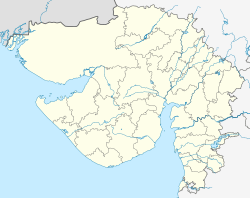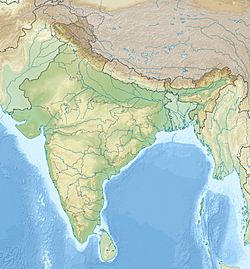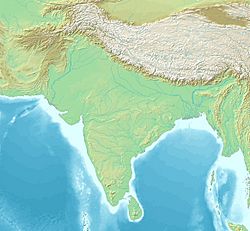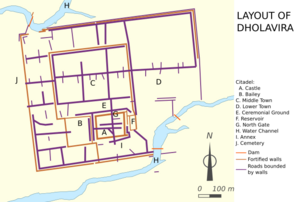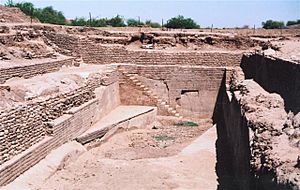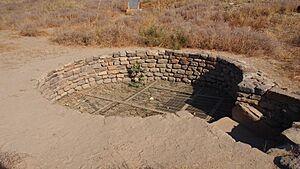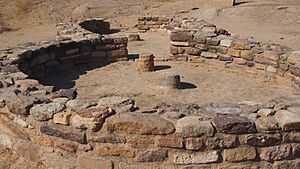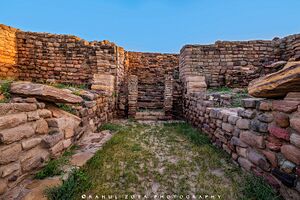Dholavira facts for kids
Dholavira is an amazing ancient city located on Khadirbet island in the Kutch district of Gujarat, India. It's a very important archaeological site from the ancient Indus Valley civilization, also known as the Harappan Civilization. Locals sometimes call it Kotada timba.
This city was once a busy place, but it's now in ruins. Scientists believe it was first settled around 3500 BCE, even before the main Harappan period, and people lived there until about 1800 BCE. Earthquakes often affected Dholavira, including a very strong one around 2600 BCE.
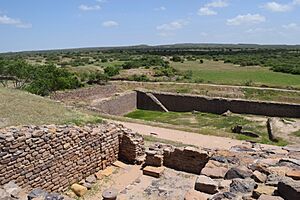
Part of the excavated site
|
|
| Location | Khadirbet, Kutch district, Gujarat, India |
|---|---|
| Coordinates | 23°53′18.98″N 70°12′49.09″E / 23.8886056°N 70.2136361°E |
| Type | Settlement |
| Area | 47 ha (120 acres) |
| History | |
| Periods | Harappa 1 to Harappa 5 |
| Cultures | Indus Valley civilization |
| Site notes | |
| Condition | Ruined |
| Public access | Yes |
| Official name | Dholavira: A Harappan City |
| Criteria | Cultural: (iii)(iv) |
| Designated | 2021 (44th session) |
| Reference no. | 1645 |
| Region | Southern Asia |
Contents
Where is Dholavira Located?
Dholavira is special because it sits right on the Tropic of Cancer. It's one of the five biggest Harappan sites ever found and a very important archaeological spot in India. The city is located on Khadir Bet island, inside the Kutch Desert Wildlife Sanctuary.
This ancient city, which is shaped like a rectangle and covers about 47 hectares (about 116 acres), was built between two seasonal streams. These streams were called the Mansar in the north and Manhar in the south.
How Dholavira Was Found
A local villager named Shambhudan Gadhvi first noticed the site in the early 1960s. He tried to tell the government about it. Later, in 1967-68, J. P. Joshi from the Archaeological Survey of India (ASI) officially discovered Dholavira.
Archaeologists have been digging at Dholavira since 1990. It's the fifth largest of the eight main Harappan sites found so far. Other big Harappan cities include Harappa, Mohenjo-daro, and Lothal.
Because of its importance, Dholavira was named a UNESCO World Heritage Site in 2021.
Dholavira Through Time
Archaeologists have divided Dholavira's history into seven main stages, showing how the city grew and changed over many centuries. Here's a simple look at its timeline:
| Stages | Time | Events |
|---|---|---|
| Stage I | 2650–2550 BCE | Early Harappan – Mature Harappan Transition A |
| Stage II | 2550–2500 BCE | Early Harappan – Mature Harappan Transition B |
| Stage III | 2500–2200 BCE | Mature Harappan A |
| Stage IV | 2200–2000 BCE | Mature Harappan B |
| Stage V | 2000–1900 BCE | Mature Harappan C |
| 1900–1850 BCE | Period of desertion | |
| Stage VI | 1850–1750 BCE | Posturban Harappan A |
| 1750–1650 BCE | Period of desertion | |
| Stage VII | 1650–1450 BCE | Posturban Harappan B |
Newer studies suggest that the first two stages, called the Pre-Harappan Dholaviran Culture, actually started much earlier. Stage I might have been from 3500-3200 BCE, and Stage II from 3200-2600 BCE.
What Excavations Revealed
When digging started in 1989, archaeologists found amazing things. They learned about the city's smart planning and buildings. They also unearthed many ancient items. These included animal bones, gold, silver, clay ornaments, pottery, and bronze pots.
Experts believe Dholavira was a major trading hub. It connected settlements in southern Gujarat, Sindh, and Punjab with places in Western Asia.
City Design and Buildings
Dholavira is older than the port city of Lothal. It has a unique rectangular shape and covers about 22 hectares (about 54 acres). The city was carefully planned with three main parts:
- The citadel (a strong fortress)
- The middle town
- The lower town
Both the citadel and the middle town had their own strong walls, gates, streets, wells, and open spaces. The citadel was the most protected part, with double walls. Next to it was a place called the 'bailey', where important officials likely lived.
One very special thing about Dholavira is that most of its buildings are made of stone. This is different from other Harappan sites like Harappa and Mohenjo-Daro, which were mostly built with bricks. Dholavira's location between two seasonal streams, the Mansar and Manhar, was also important for its water supply.
Amazing Water System
One of the most impressive features of Dholavira is its advanced water system. The people of Dholavira were experts at collecting, saving, and storing water. This was very important because Kutch, where Dholavira is located, is a desert area that often goes many years without rain.
The city had huge reservoirs, which are like big tanks for storing water. These were built entirely of stone. They collected rainwater or water diverted from the nearby streams. Archaeologists have found at least three of these large reservoirs. Some were dug into the rock itself.
These reservoirs are very deep, about 7 meters (23 feet) deep and 79 meters (259 feet) long. They surround the city, while the citadel and a bathing area are in the center on higher ground. There was also a large well connected to a drain that carried water to a storage tank. One bathing tank even had steps leading down into it.
In 2014, archaeologists started digging a rectangular stepwell. It was huge, measuring 73.4 meters (241 feet) long, 29.3 meters (96 feet) wide, and 10 meters (33 feet) deep. This makes it three times bigger than the famous Great Bath of Mohenjedaro!
Seal Making and Other Finds
Some seals found at Dholavira show only animal figures, without any writing. This suggests they might be early examples of how Indus seals were made.
Archaeologists also found a huge circular structure. It might have been a grave or a memorial, even though no human remains were found inside it. It was built with ten mud-brick walls shaped like a spoked wheel. A soft stone sculpture of a man was found near the eastern gate. Many other items were discovered, including:
- Pottery pieces
- Clay seals
- Bangles, rings, and beads
- Engraved objects
Hemispherical Buildings
Seven dome-shaped buildings were found at Dholavira. Two of these were carefully excavated. They were large, round, elevated structures made of mud bricks, built over rock-cut chambers. One was designed like a spoked wheel, and another like a wheel without spokes.
Most of these structures did not contain skeletons, but one grave had a skeleton and a copper mirror. Other treasures found included a necklace of beads on a copper wire, a gold bangle, and other gold beads. The Archaeological Survey of India believes these dome-shaped buildings might be similar to early Buddhist stupas.
What Else Was Found?
Many interesting artifacts were found at Dholavira, giving us clues about the lives of its ancient people:
- Painted pottery with black designs on red clay.
- Square stamp seals.
- A huge signboard, about 3 meters (10 feet) long, with ten large letters of the Indus script.
- A stone sculpture of a seated male figure, similar to high-quality sculptures from Harappa.
- Large black jars with pointed bottoms.
- A giant bronze hammer, a big chisel, and a bronze hand-held mirror.
- Gold items like a gold wire, an ear stud, and small gold beads.
- Copper tools and bangles.
- Shell bangles.
- Seals with Indus writing and symbols, including a circular seal.
- Pottery with painted patterns, goblets, dishes on stands, and jars with holes.
- Clay tumblers in good condition.
- Building parts made of ballast stones.
- Grinding stones and mortars.
- Stone weights of different sizes, showing they had a system for measuring things.
Language and Script
The people of the Harappan civilization spoke a language that we don't know today. Their writing system, called the Indus script, has not yet been figured out. It's thought to have about 400 basic signs, with many variations. These signs might have stood for both words and syllables.
Most of the writing found is on seals (usually made of stone) and clay pieces where seals were pressed. Some writing is also found on copper tablets and small objects made of clay, stone, and a material called faience. These seals were likely used for trade and official paperwork.
The Dholavira Signboard

One of the most exciting discoveries at Dholavira is known as the Dholavira Signboard. It was found in a side room near the city's northern gate. The Harappans had arranged ten large symbols or letters using pieces of a mineral called gypsum on a big wooden board. Over time, the wood rotted away, but the arrangement of the letters stayed in place.
These letters are very large, about 37 centimeters (14.5 inches) high, and the board itself was about 3 meters (10 feet) long. This inscription is one of the longest ever found in the Indus script. One of the symbols appears four times. Because of its large size and public location, many scholars believe this signboard is strong evidence that the Indus script was a complete writing system. Another inscription with four large letters on sandstone was also found here, which is the first of its kind at any Harappan site.
Images for kids


